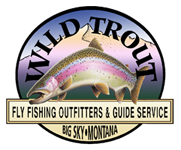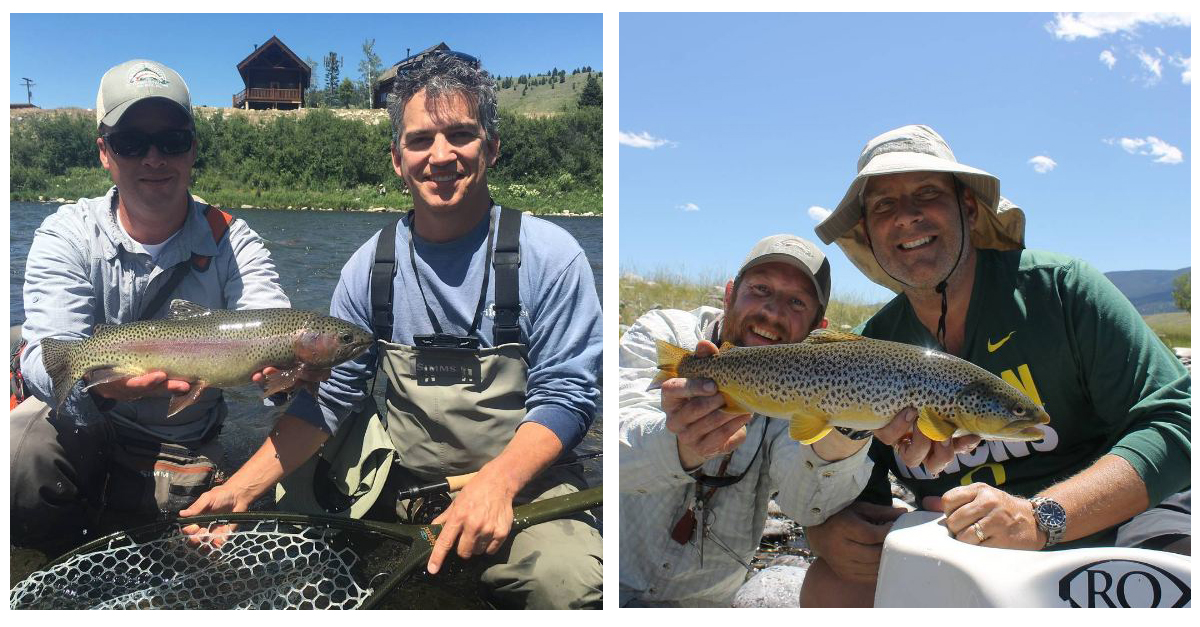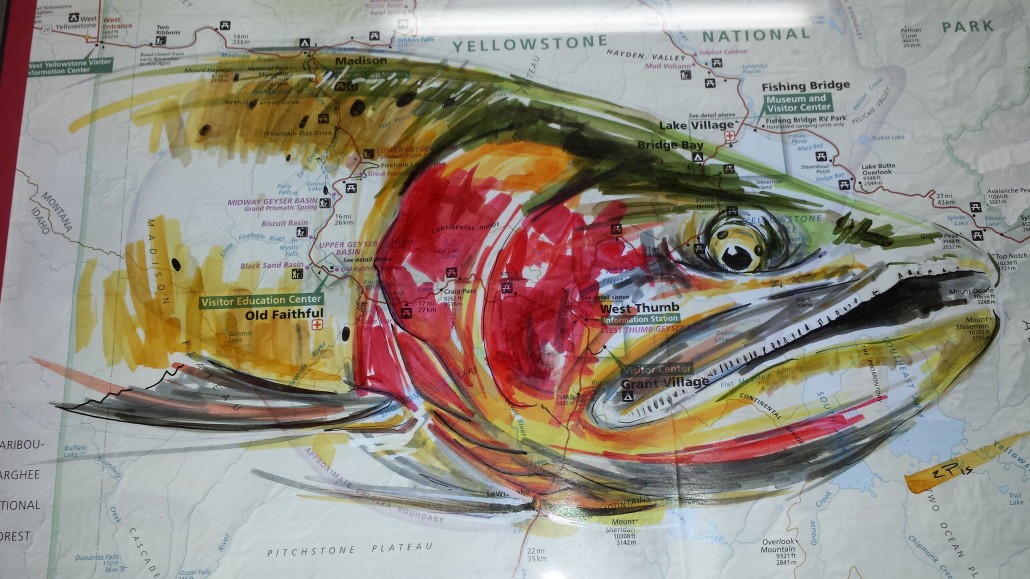GALLATIN RIVER FISHING REPORT
The Gallatin is about as good as it gets right now. The water is in great shape, bugs are hatching, and the trout are consistently eating a variety of nymphs and dries.
Our clients have had some banner days on the Gallatin lately.
Guide trips and dialed-in DIY anglers are catching good numbers of fish, mostly subsurface. There are certainly opportunities to do some productive headhunting or even blind fishing with dries. By “dialed-in” DIY anglers we’re talking about anglers who know the river. Some are locals, but many are folks from elsewhere who return frequently to fish the Gallatin. So how do you flatten the learning curve if you’re new to the Gallatin? The best way to quickly learn what works is to hire a guide. Show up ready to learn and ask a lot of questions.
Take note of the type of water the guide puts you in throughout the day.
Take note on how they approach the water and the way they rig your rod.Take note on the fly patterns that they rotate through (ask the names of these flies and try to remember a few of them). Guides love anglers who are eager to learn.If a guide isn’t an option, stop by the shop and buy some flies, a couple of fresh leaders and a spool of 5x. Ask a few questions to help get you pointed in the right direction, that’s what we’re here for.
The big stoneflies have come and gone on the Gallatin.
Some yellow sallies remain and fish are looking for them – a size 14, yellow-bodied Stimulator is a good choice for picking off random risers or for doing a little prospecting through likely holding water. Caddis are providing consistent action early and late in the day and an olive or brown x-caddis will typically suffice. If you’re seeing rise forms during caddis times, but your dry flies aren’t connecting, try swinging a soft hackle nymph… they do a good job of imitating an emerging caddis rising to the surface.
PMD mayflies are out in good numbers many days, particularly south of Big Sky
On overcast afternoon’s with light wind can produce excellent fishing on pale-colored mayfly duns in the size 16 to 18 range. And if that’s not enough, sporadic green drake hatches have been occurring on the upper river, primarily within Yellowstone National Park – when these size 12 mayflies are hatching the fish take notice!
With all of that insect activity there are plenty of opportunities to take fish on dries.
Anglers running nymph rigs are outfishing the dry-fly-only guys by a wide margin… it’s not even close. With all of the insect activity going on right now we’re seeing a wide variety of nymph patterns taking fish, but most are on the smaller side of the spectrum… 16 to 18 and even 20’s. Various slim-bodied mayfly nymphs are excelling as are the seemingly endless variations of the Serendipity and Shop Vac patterns. Our guides are also reporting lots of action on soft-hackle patterns – particularly Pheasant Tails and Hare’s Ears… dead-drift them, but let them swing out at the end of the drift.
All in all it’s a great time to be out on the Gallatin, give us a call to book a trip.
Dries:
Stimulator (Yellow) #14-16, Elk Hair Caddis (Yellow/Tan/Olive) #14-16, X-Caddis (Olive) #14-16, Lime Trude #12-16, Sparkle Dun (PMD) #16-18, Sparkle Dun (Green Drake) #12, Purple Haze #14-18
Nymphs:
Pheasant Tail #16-18, Soft-Hackle Pheasant Tail #16-18, Soft-Hackle Hare’s Ear #16-18. Lightning Bug #16-18, Copper John #14-16, Beadhead Yellow Sally #14-16, CDC Emerger #14-18,.Shop Vac #16-18, Serendipity (Red/Crystal) #16-18, Zebra Midge (Black/Olive) #18-20
Streamers:
Sparkle Minnow #4-6, Bow River Bugger #4-6, Home Invader #2-6, McCune’s Sculpin#4, Gonga #4. Be sure to have an array of colors represented in your streamer box. Including: white, yellow, olive, natural/tan, and black.
UPPER MADISON FISHING REPORT
The upper Madison is fishing very well. The dry fly fishing has been good, and salmonflies are still in play.
The upper Madison is fishing as well as many of us can remember.
The old timers are saying it reminds them of the good old days when the river was a dry fly fishery first and foremost. The dry fly bite has certainly been solid, and the nymph bite has been hot. Flows out of Hebgen Dam have been bumped back up to seasonal norms. Many anglers believe that cooler water temperatures are resulting in the good dry fly fishing.
Caddis activity early (dawn to mid-morning) and late (early evening to dusk)
Caddis hatch is providing consistent dry fly fishing, with fish readily taking adults and emergers. By late morning as the caddis activity is waning, PMDs begin emerging, typically continuing into the afternoon hours. There are still some salmonflies and golden stones kicking around up high above Reynolds Pass, but these hatches are petering out.During non-hatch periods anglers are having some success blind fishing with attractor patterns such as a Stimulator, Trude, or Purple Haze… dropping a beadhead nymph below your dry fly is a great insurance policy when working likely holding water.
The nymph fishing has been very good on an assortment of caddis larva and pupa in sizes 16-18.
You can use PMD nymphs in size 16-18 and yellow sally nymphs in sizes 14-16. Larger stonefly nymphs are still producing fish… nocturnal stonefly nymphs are migrating toward the banks adjacent to faster water.
Whether you prefer the upper walk/wade reaches of the Madison, or the famous float stretch you really can’t go wrong right now. Call us today to reserve your guide dates for the summer!
Nymphs:
Pats’ Rubber Legs #8, Mega Prince #8, Pheasant Tail #16-18, Soft-Hackle Lightning Bug #16-18, Lightning Bug #16-18, Shop Vac #16-18. $3 Dip #16-18, Crystal Dip #16-18, Anato-May #16, Military May #16
Dries:
Stimulator (Yellow) #14, Elk Hair Caddis (Tan/Olive) #14-16, X-Caddis (Olive) #14-16, Trude (Lime/Adams Grey) #12-16. Sparkle Dun (PMD) #16-18, Sparkle Dun (Green Drake) #12
Streamers:
Sex Dungeon #4, Circus Peanut #4, Barely Legal, Sparkle Minnow #4-6, Bow River Bugger #4-6, Home Invader #2-6, McCune’s Sculpin#4, Gonga #4. Be sure to have an array of colors represented in your streamer box.Including: white, yellow, olive, natural/tan, and black.
YELLOWSTONE RIVER FISHING REPORT
The Yellowstone is fishing well and while it may not always produce as many fish as the Madison or Gallatin, it has the most potential to produce BIG fish.
The Yellowstone is fishing well.
The river has been experiencing some mud plugs due to rainfall in the park. Guides and anglers are almost always able to work around these mud plugs and fishing behind them as the river clears can yield great results.The salmonfly hatch is done for this year. There may be a few still kicking around up in the canyons of Yellowstone National Park. So Caddis and PMDs are out and anglers who are dedicated to the dry fly can expect some action. Larger attractor dries are getting some attention, particularly early and late in the day. We’re hearing reports of some nocturnal stonefly shucks being spotted along the river down low… as that hatch ramps up we’ll see more and more action on larger stonefly and attractor dry flies.
The nymph fishing has been solid
Use tandem rigs consisting of a larger lead fly (Wooly Bugger, Pat’s Rubber Leg, Bow River Bugger, Sparkle Minnow or Zonker to name a few) trailed by a smaller beadhead nymph (Shop Vacs, CDC Pheasant Tails, Serendipities and Lightning Bugs have been productive). Ripping streamers off the banks has had its moments, but has slowed considerably with the increased insect activity… smaller streamers dead drifted below an indicator have been finding more success.
Dries:
Chubby Chernobyl (tan) #8-10, Stimulator (Yellow) #14, Elk Hair Caddis (Tan/Olive) #14-16. X-Caddis (Olive) #14-16, Lime Trude #12-16, Sparkle Dun (PMD) #16-18, Purple Haze #14-18
Nymphs:
Pats’ Rubber Legs #8, Mega Prince #8, San Juan Worm (Red) #12, CDC Pheasant Tail #16-18, Pheasant Tail #16-18, Lightning Bug #16-18. Copper John #14-16, Beadhead Yellow Sally #14, CDC Emerger #14-18, Shop Vac #16, Serendipity (Red/Crystal) #16-18.
Streamers:
Sex Dungeon #4, Circus Peanut #4, Barely Legal, Sparkle Minnow #4-6, Bow River Bugger #4-6, Home Invader #2-6, McCune’s Sculpin#4, Gonga #4. Be sure to have an array of colors represented in your streamer box. Including: white, yellow, olive, natural/tan, and black.
YELLOWSTONE NATIONAL PARK FISHING REPORT
The Firehole and Madison have warmed considerably and are largely out of play for anglers. The Gibbon remains a productive option on the west side, and the entire Yellowstone watershed is rounding into shape.
The Firehole and Madison in the park have warmed considerably and are no longer good options. The Gibbon River is fishing well along its entire length, providing a good option for anglers on the west side of the park. Further north, the Yellowstone is in prime shape with a few salmonflies and golden stoneflies still kicking around in the canyon reaches… the attractor dry fly fishing has been excellent.
The Yellowstone’s tributaries including the Lamar River and Slough Creek are now in fishable shape with emergences of PMDs and drakes bringing trout to the surface.
Give us a call (800-423-4742) to discuss planning your own trip.
Dries: Adams #18-20, Sparkle Dun – Olive (baetis), Yellow (PMD) #18-20, Purple Haze #18-20, Light Cahill #16-18
Nymphs: Pheasant Tail #18-20, Soft-Hackle Pheasant Tail #18-20, CDC Emerger #18-20, Partridge & Olive Soft Hackle #18-20, Lightning Bug #18-20, WD-40 #18-20, RS-2 #18-20, Pat’s Rubber Leg #8




